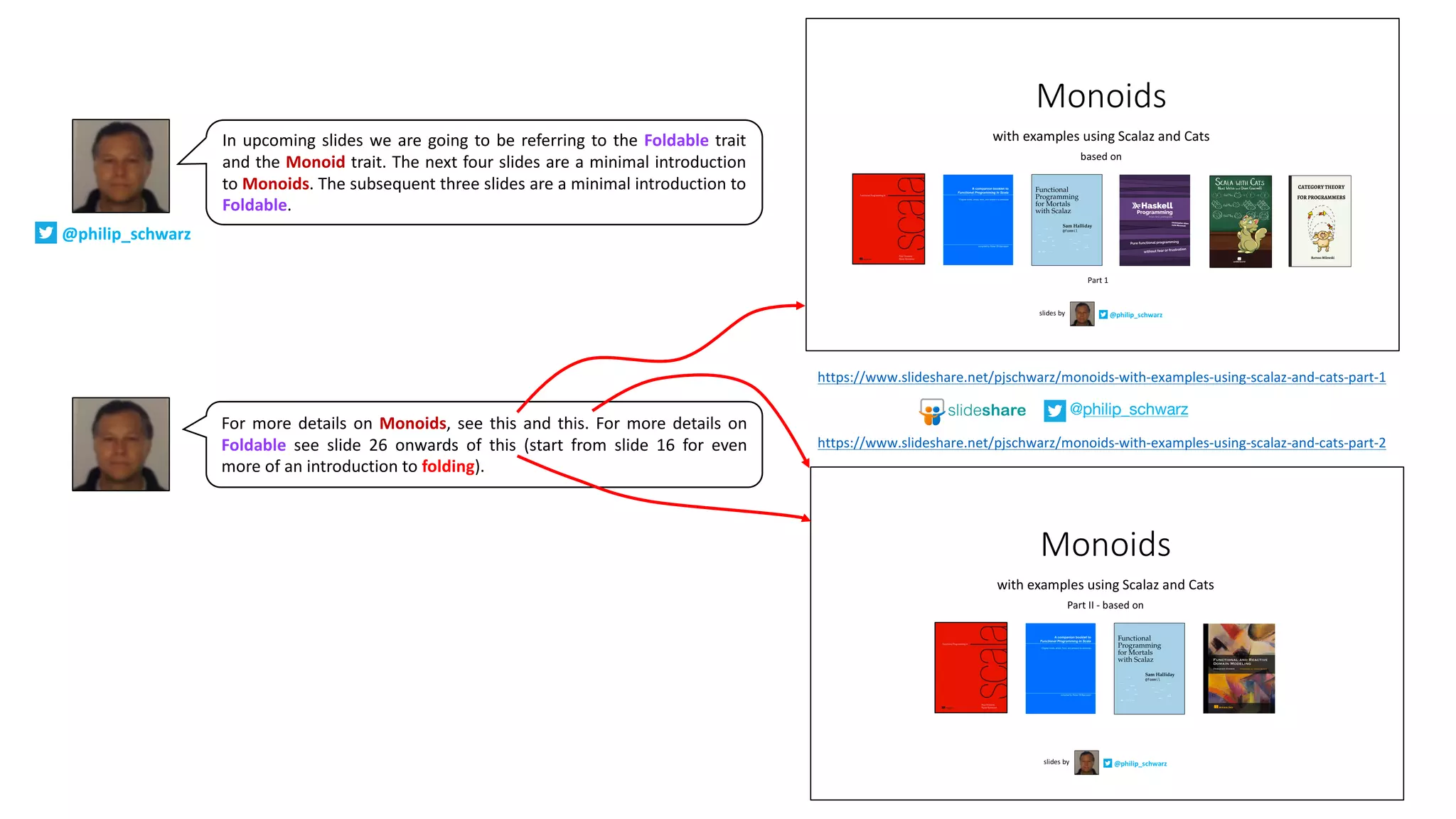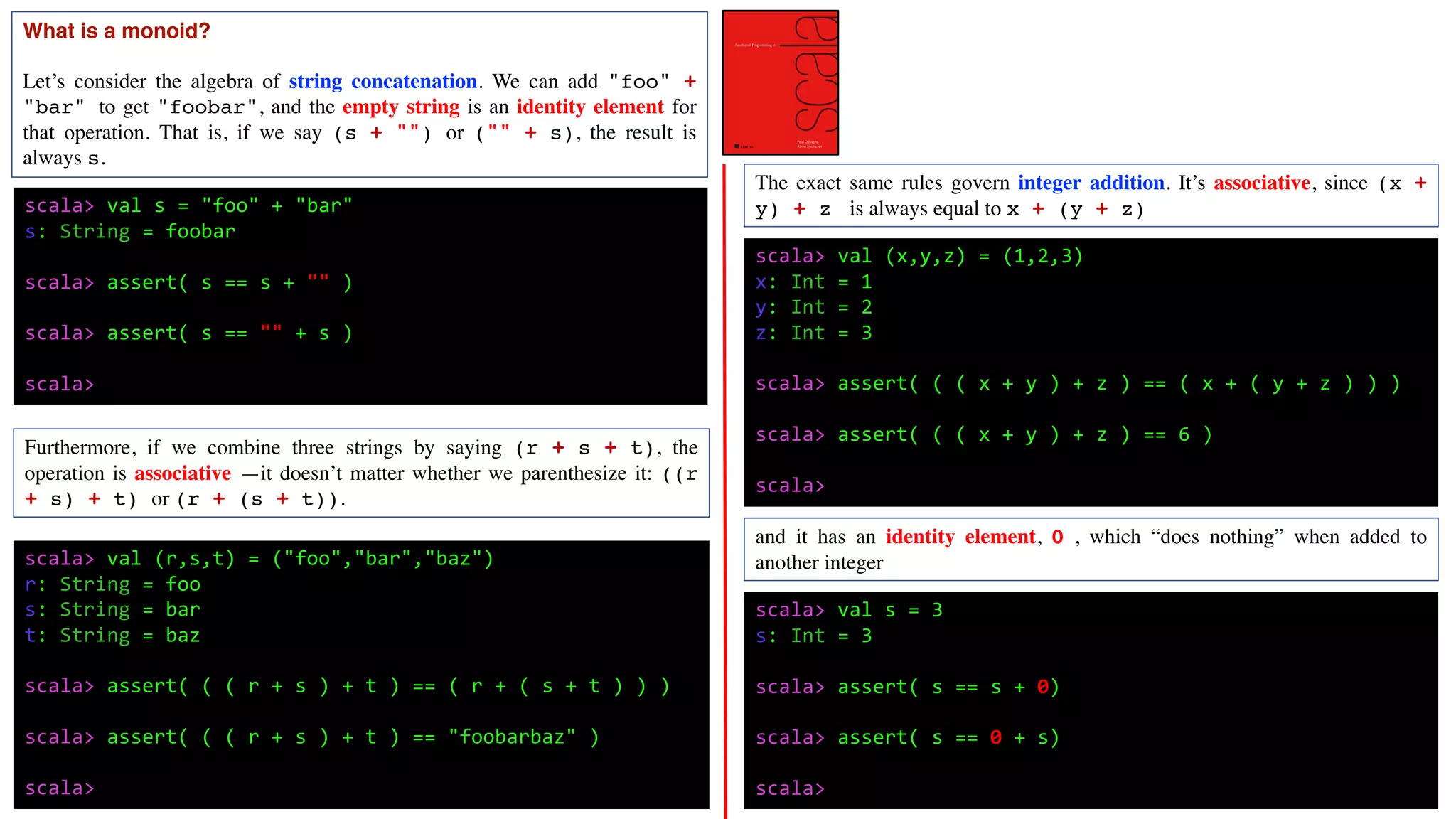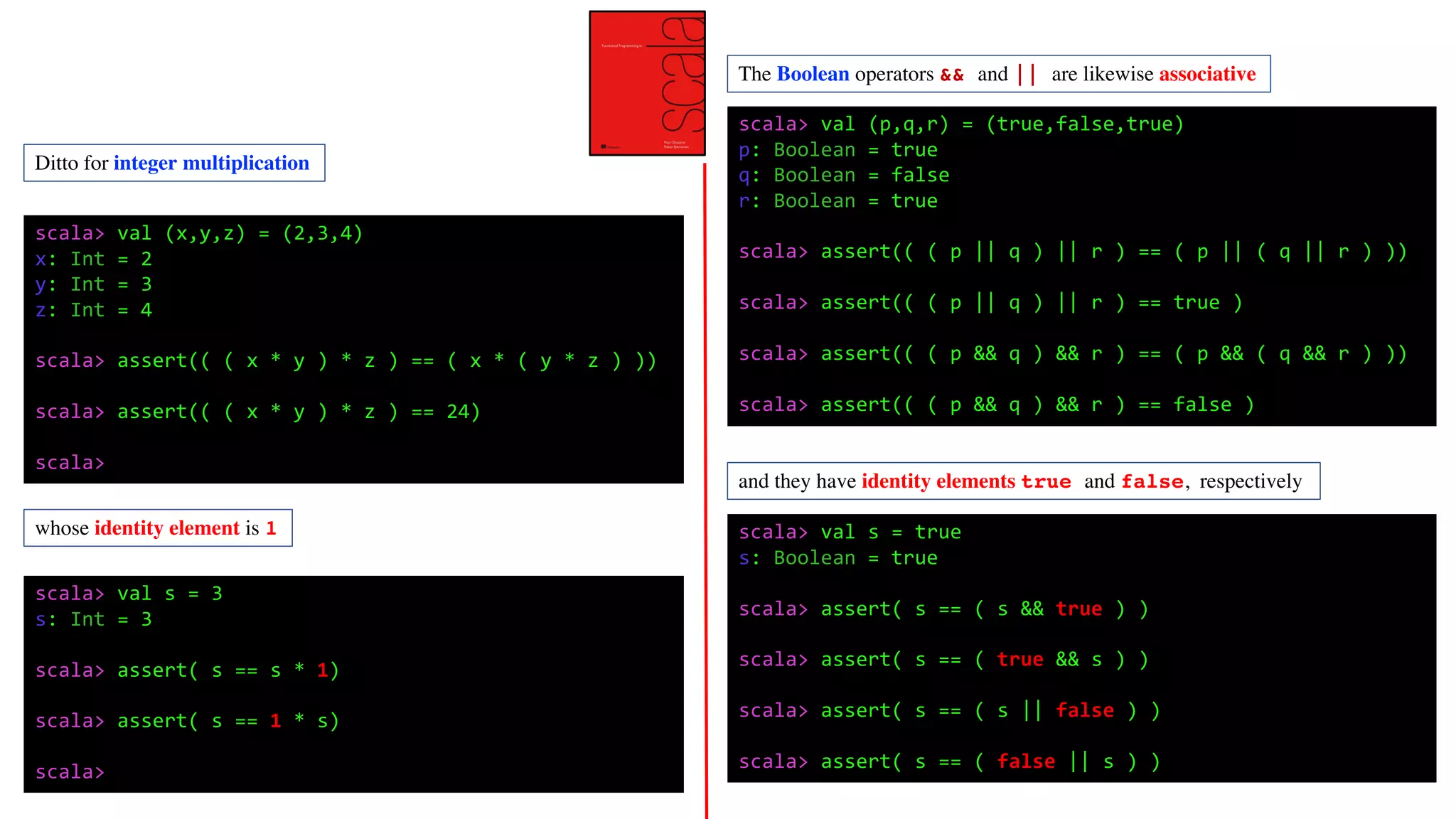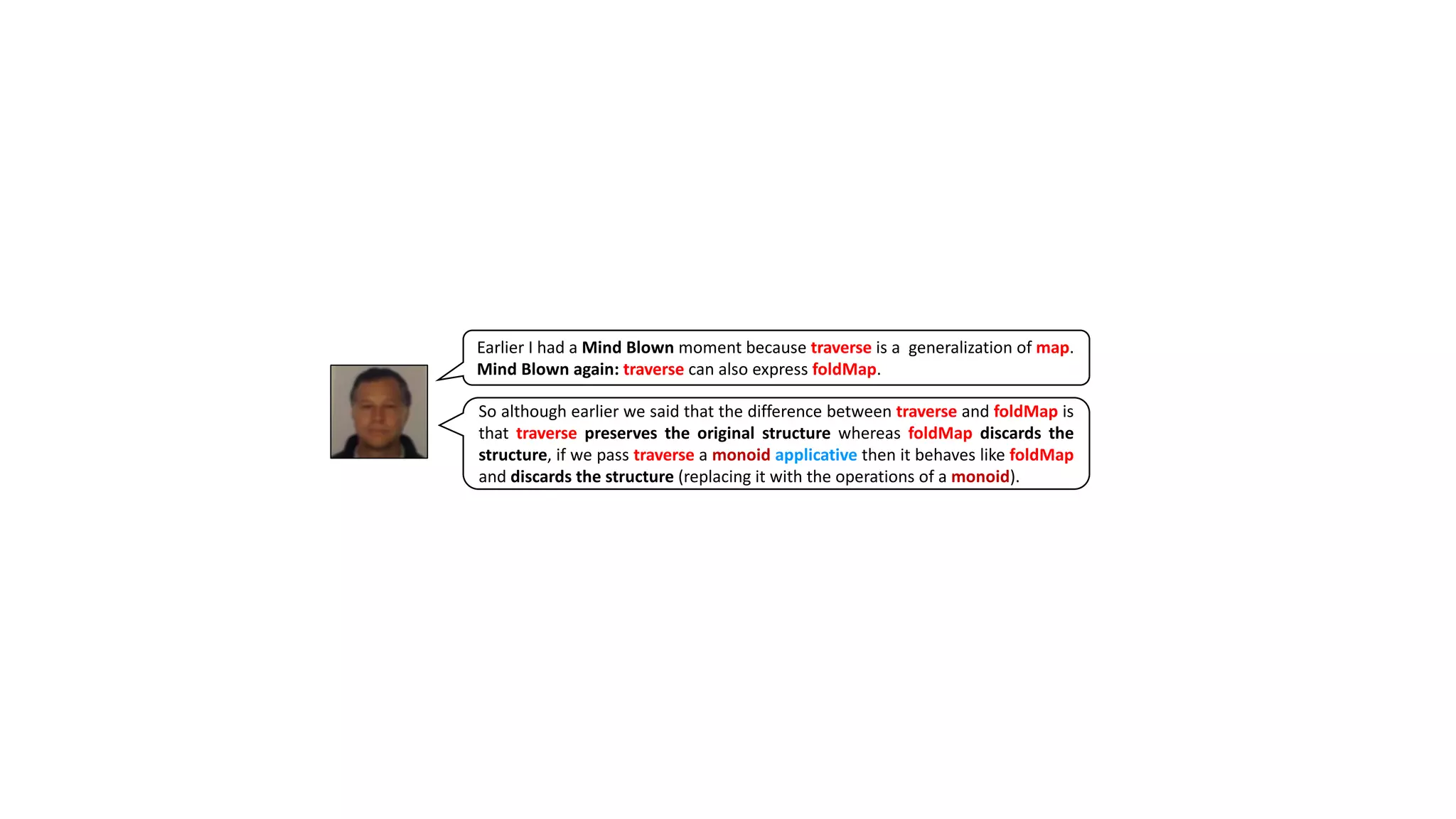The document discusses 'traverse' and 'sequence' functions in functional programming within Scala, focusing on their application across different data types like lists, trees, and maps. It introduces concepts of monoids and foldable data structures, detailing operations and properties such as associativity and identity elements. Additionally, it emphasizes the utility of monoids and foldable types in writing generic code while providing practical examples and implementations.

![We now have instances of Traverse for List, Option, Map, and Tree . What does this generalized traverse /sequence
mean? Let’s just try plugging in some concrete type signatures for calls to sequence. We can speculate about what these functions
do, just based on their signatures:
• List[Option[A]] => Option[List[A]] (a call to Traverse[List].sequence with Option as the
Applicative ) returns None if any of the input List is None; otherwise it returns the original List wrapped in Some.
• Tree[Option[A]] => Option[Tree[A]] (a call to Traverse[Tree].sequence with Option as the
Applicative ) returns None if any of the input Tree is None; otherwise it returns the original Tree wrapped in Some.
• Map[K, Par[A]] => Par[Map[K,A]] (a call to Traverse[Map[K,_]].sequence with Par as the
Applicative ) produces a parallel computation that evaluates all values of the map in parallel.
Functional Programming in Scala
(by Paul Chiusano and Runar Bjarnason)
@pchiusano @runarorama
trait Traverse[F[_]] {
def traverse[M[_]:Applicative,A,B](fa: F[A])(f: A => M[B]): M[F[B]]
sequence(map(fa)(f))
def sequence[M[_]:Applicative,A](fma: F[M[A]]): M[F[A]] =
traverse(fma)(ma => ma)
}](https://image.slidesharecdn.com/sequence-and-traverse-part-3-190310112101/75/Sequence-and-Traverse-Part-3-2-2048.jpg)



![These are just a few simple examples, but algebras like this are virtually everywhere. The term for this kind of algebra is monoid.
The laws of associativity and identity are collectively called the monoid laws.
A monoid consists of the following:
• Some type A
• An associative binary operation, op, that takes two values of type A and combines them into one: op(op(x,y), z) == op(x, op(y,z)) for any
choice of x: A, y: A, z: A
• A value, zero: A, that is an identity for that operation: op(x, zero) == x and op(zero, x) == x for any x: A
trait Monoid[A] {
def op(a1: A, a2: A): A
def zero: A
}
val stringMonoid = new Monoid[String] {
def op(a1: String, a2: String) = a1 + a2
val zero = ""
}
An example instance of this trait is the String monoid:
def listMonoid[A] = new Monoid[List[A]] {
def op(a1: List[A], a2: List[A]) = a1 ++ a2
val zero = Nil
}
List concatenation also forms a monoid:
Functional Programming in Scala
(by Paul Chiusano and Runar Bjarnason)
@pchiusano @runarorama
We can express this with a Scala trait:
List function returning a new list containing the elements from the left
hand operand followed by the elements from the right hand operand
String concatenation function](https://image.slidesharecdn.com/sequence-and-traverse-part-3-190310112101/75/Sequence-and-Traverse-Part-3-6-2048.jpg)
![Monoid instances for integer addition and multiplication as well as the Boolean operators
implicit val intAdditionMonoid = new Monoid[Int] {
def op(x: Int, y: Int) = x + y
val zero = 0
}
implicit val intMultiplicationMonoid = new Monoid[Int] {
def op(x: Int, y: Int) = x * y
val zero = 1
}
Just what is a monoid, then? It’s simply a type A and an implementation of Monoid[A] that satisfies the laws.
Stated tersely, a monoid is a type together with a binary operation (op) over that type, satisfying associativity and having an
identity element (zero).
What does this buy us? Just like any abstraction, a monoid is useful to the extent that we can write useful generic code assuming
only the capabilities provided by the abstraction. Can we write any interesting programs, knowing nothing about a type other
than that it forms a monoid? Absolutely!
implicit val booleanOr = new Monoid[Boolean] {
def op(x: Boolean, y: Boolean) = x || y
val zero = false
}
implicit val booleanAnd = new Monoid[Boolean] {
def op(x: Boolean, y: Boolean) = x && y
val zero = true
}
Functional Programming in Scala
(by Paul Chiusano and Runar Bjarnason)
@pchiusano @runarorama
(by Runar Bjarnason)
@runarorama](https://image.slidesharecdn.com/sequence-and-traverse-part-3-190310112101/75/Sequence-and-Traverse-Part-3-7-2048.jpg)

![Foldable data structures
In chapter 3, we implemented the data structures List and Tree, both of which could be folded. In chapter 5, we wrote
Stream, a lazy structure that also can be folded much like a List can, and now we’ve just written a fold for IndexedSeq.
When we’re writing code that needs to process data contained in one of these structures, we often don’t care about the shape
of the structure (whether it’s a tree or a list), or whether it’s lazy or not, or provides efficient random access, and so forth.
For example, if we have a structure full of integers and want to calculate their sum, we can use foldRight:
ints.foldRight(0)(_ + _)
Looking at just this code snippet, we shouldn’t have to care about the type of ints. It could be a Vector, a Stream, or a
List, or anything at all with a foldRight method. We can capture this commonality in a trait:
Functional Programming in Scala
(by Paul Chiusano and Runar Bjarnason)
@pchiusano @runarorama
trait Foldable[F[_]] {
def foldRight[A,B](as: F[A])(z: B)(f: (A,B) => B): B
def foldLeft[A,B](as: F[A])(z: B)(f: (B,A) => B): B
def foldMap[A,B](as: F[A])(f: A => B)(mb: Monoid[B]): B
def concatenate[A](as: F[A])(m: Monoid[A]): A =
foldLeft(as)(m.zero)(m.op)
}
Here we’re abstracting over a type constructor F, much like we did with the
Parser type in the previous chapter. We write it as F[_], where the
underscore indicates that F is not a type but a type constructor that takes
one type argument. Just like functions that take other functions as arguments
are called higher-order functions, something like Foldable is a higher-
order type constructor or a higher-kinded type .7
7 Just like values and functions have types, types and type constructors
have kinds. Scala uses kinds to track how many type arguments a type
constructor takes, whether it’s co- or contravariant in those arguments, and
what the kinds of those arguments are.](https://image.slidesharecdn.com/sequence-and-traverse-part-3-190310112101/75/Sequence-and-Traverse-Part-3-9-2048.jpg)
![EXERCISE 10.12
Implement Foldable[List], Foldable[IndexedSeq], and Foldable[Stream]. Remember that foldRight, foldLeft,
and foldMap can all be implemented in terms of each other, but that might not be the most efficient implementation.
A Companion booklet to
FP in Scala
FP in Scala
trait Foldable[F[_]] {
def foldRight[A, B](as: F[A])(z: B)(f: (A, B) => B): B =
foldMap(as)(f.curried)(endoMonoid[B])(z)
def foldLeft[A, B](as: F[A])(z: B)(f: (B, A) => B): B =
foldMap(as)(a => (b: B) => f(b, a))(dual(endoMonoid[B]))(z)
def foldMap[A, B](as: F[A])(f: A => B)(mb: Monoid[B]): B =
foldRight(as)(mb.zero)((a, b) => mb.op(f(a), b))
def concatenate[A](as: F[A])(m: Monoid[A]): A =
foldLeft(as)(m.zero)(m.op)
}
object ListFoldable extends Foldable[List] {
override def foldRight[A, B](as:List[A])(z:B)(f:(A,B)=>B) =
as.foldRight(z)(f)
override def foldLeft[A, B](as:List[A])(z:B)(f:(B,A)=>B) =
as.foldLeft(z)(f)
override def foldMap[A, B](as:List[A])(f:A=>B)(mb:Monoid[B]):B =
foldLeft(as)(mb.zero)((b, a) => mb.op(b, f(a)))
}
object IndexedSeqFoldable extends Foldable[IndexedSeq] {…}
object StreamFoldable extends Foldable[Stream] {
override def foldRight[A, B](as:Stream[A])(z:B)(f:(A,B)=>B) =
as.foldRight(z)(f)
override def foldLeft[A, B](as:Stream[A])(z:B)(f:(B,A)=>B) =
as.foldLeft(z)(f)
}
assert( ListFoldable.foldLeft(List(1,2,3))(0)(_+_) == 6)
assert( ListFoldable.foldRight(List(1,2,3))(0)(_+_) == 6)
assert( ListFoldable.concatenate(List(1,2,3))(intAdditionMonoid) == 6)
assert( ListFoldable.foldMap(List("1","2","3"))(_ toInt)(intAdditionMonoid) == 6)
assert( StreamFoldable.foldLeft(Stream(1,2,3))(0)(_+_) == 6)
assert( StreamFoldable.foldRight(Stream(1,2,3))(0)(_+_) == 6)
assert( StreamFoldable.concatenate(Stream(1,2,3))(intAdditionMonoid) == 6)
assert( StreamFoldable.foldMap(Stream("1","2","3"))(_ toInt)(intAdditionMonoid) == 6)
assert( ListFoldable.foldLeft(List("a","b","c"))("")(_+_) == "abc")
assert( ListFoldable.foldRight(List("a","b","c"))("")(_+_) == "abc")
assert( ListFoldable.concatenate(List("a","b","c"))(stringMonoid) == "abc")
assert( ListFoldable.foldMap(List(1,2,3))(_ toString)(stringMonoid) == "123")
assert( StreamFoldable.foldLeft(Stream("a","b","c"))("")(_+_) == "abc")
assert( StreamFoldable.foldRight(Stream("a","b","c"))("")(_+_) == "abc")
assert( StreamFoldable.concatenate(Stream("a","b","c"))(stringMonoid) == "abc")
assert( StreamFoldable.foldMap(Stream(1,2,3))(_ toString)(stringMonoid) == "123")
Using the methods of ListFoldable
and StreamFoldable to fold
Lists/Streams of Ints and Strings.
If you are new to monoids, don’t worry about the
implementation of foldRight and foldLeft except for the
fact that it is possible to define them using foldMap.](https://image.slidesharecdn.com/sequence-and-traverse-part-3-190310112101/75/Sequence-and-Traverse-Part-3-10-2048.jpg)
![Sam Halliday
@fommil
Technically, Foldable is for data structures that can be walked to produce a summary value. However, this
undersells the fact that it is a one-typeclass army that can provide most of what you’d expect to see in a
Collections API.
You might recognise foldMap by its marketing buzzword name, MapReduce. Given an F[A], a function from A to
B, and a way to combine B (provided by the Monoid, along with a zero B), we can produce a summary value of
type B. There is no enforced operation order, allowing for parallel computation.
foldRight does not require its parameters to have a Monoid, meaning that it needs a starting value z and a
way to combine each element of the data structure with the summary value. The order for traversing the
elements is from right to left and therefore it cannot be parallelised.
foldLeft traverses elements from left to right. foldLeft can be implemented in terms of foldMap, but most
instances choose to implement it because it is such a basic operation. Since it is usually implemented with
tail recursion, there are no byname parameters.
The simplest thing to do with foldMap is to use the identity function, giving fold (the natural sum of the
monoidal elements), with left/right variants to allow choosing based on performance criteria:
@typeclass trait Foldable[F[_]] {
def foldMap[A, B: Monoid](fa: F[A])(f: A => B): B
def foldRight[A, B](fa: F[A], z: =>B)(f: (A, =>B) => B): B
def foldLeft[A, B](fa: F[A], z: B)(f: (B, A) => B): B = ...
def fold[A: Monoid](t: F[A]): A = ...
def sumr[A: Monoid](fa: F[A]): A = ...
def suml[A: Monoid](fa: F[A]): A = ...
…
In FPiS, fold is called
concatenate.
Sam Halliday
Anything you’d expect to find in a collection library is
probably on Foldable and if it isn’t already, it probably
should be.](https://image.slidesharecdn.com/sequence-and-traverse-part-3-190310112101/75/Sequence-and-Traverse-Part-3-11-2048.jpg)

![A traversal is similar to a fold in that both take some data structure and apply a function to the data within in order to produce a result.
The difference is that traverse preserves the original structure , whereas foldMap discards the structure and replaces it with
the operations of a monoid.
Look at the signature Tree[Option[A]] => Option[Tree[A]], for instance.
We’re preserving the Tree structure, not merely collapsing the values using some monoid.
trait Traverse[F[_]] {
def traverse[M[_]:Applicative,A,B](as: F[A])(f: A => M[B]): M[F[B]]
def sequence[M[_]:Applicative,A](fma: F[M[A]]): M[F[A]] =
traverse(fma)(ma => ma)
}
trait Foldable[F[_]] {
def foldRight[A, B](as: F[A])(z: B)(f: (A, B) => B): B =
foldMap(as)(f.curried)(endoMonoid[B])(z)
def foldLeft[A, B](as: F[A])(z: B)(f: (B, A) => B): B =
foldMap(as)(a => (b: B) => f(b, a))(dual(endoMonoid[B]))(z)
def foldMap[A, B](as: F[A])(f: A => B)(mb: Monoid[B]): B =
foldRight(as)(mb.zero)((a, b) => mb.op(f(a), b))
def concatenate[A](as: F[A])(m: Monoid[A]): A =
foldLeft(as)(m.zero)(m.op)
}
traverse(as: Tree[String])(f: String => Option[Int])(implicit G: Applicative[Option]): Option[Tree[Int]]
foldMap(as: Tree[String])(f: String => Int) (implicit mb: Monoid[Int]) : Int
// foldMap using integer addition monoid
//
// "2" --> 2 --> 6
// / /
// "1" "3" 1 3
// traverse
//
// "2" --> Some(2) --> Some( 2 )
// / / /
// "1" "3" Some(1) Some(3) 1 3
To illustrate this difference between how traverse preserves the structure of
a Tree and foldMap collapses the structure using some monoid, we are
going to look at an example in which both traverse and foldMap convert the
elements of the Tree from String values to Int values, but while
traverse produces an Option[Tree[Int]], foldMap produces an Int.
FP in Scala
See the next
slide for the
full example.
@philip_schwarz](https://image.slidesharecdn.com/sequence-and-traverse-part-3-190310112101/75/Sequence-and-Traverse-Part-3-13-2048.jpg)

val tree = Tree("2",List(Tree("1", Nil), Tree("3", Nil)))
val toInt: String => Int = _.toInt
val folded = 6
assert( treeFoldable.foldMap(tree)(toInt)(intMonoid) == folded )
// treeFoldable.foldMap(tree)(toInt)(intMonoid)
//
// "2" --> 2 --> 6
// / /
// "1" "3" 1 3
// treeTraverse.traverse(tree)(parseInt)(optionApplicative)
//
// "2" --> Some(2) --> Some( 2 )
// / / /
// "1" "3" Some(1) Some(3) 1 3
val listTraverse = new Traverse[List] {
override def traverse[M[_],A,B](as:List[A])(f: A=>M[B])(implicit M:Applicative[M]):M[List[B]] =
as.foldRight(M.unit(List[B]()))((a, fbs) => M.map2(f(a), fbs)(_ :: _))
}
val treeTraverse = new Traverse[Tree] {
override def traverse[G[_],A,B](ta:Tree[A])(f: A=>G[B])(implicit G:Applicative[G]):G[Tree[B]] =
G.map2(f(ta.head),
listTraverse.traverse(ta.tail)(a => traverse(a)(f)))(Tree(_, _))
}
implicit val optionApplicative = new Applicative[Option] {
def map2[A, B, C](fa: Option[A], fb: Option[B])(f: (A, B) => C): Option[C] =
(fa, fb) match {
case (Some(a), Some(b)) => Some(f(a,b))
case _ => None
}
def unit[A](a: => A): Option[A] = Some(a)
}
val treeFoldable = new Foldable[Tree] {
override def foldMap[A,B](as:Tree[A])(f:A=>B)(mb:Monoid[B]):B =
as match {
case Tree(head,Nil) =>
f(head)
case Tree(head,tree::rest) =>
mb.op(foldMap(Tree(head,rest))(f)(mb),
foldMap(tree)(f)(mb))
}
}
val parseInt: String => Option[Int] = x => Try{ x.toInt }.toOption
val traversed = Some(Tree(2,List(Tree(1,Nil), Tree(3,Nil))))
assert( treeTraverse.traverse(tree)(parseInt)(optionApplicative) == traversed )
// "2"
// /
// "1" "3"
implicit val intMonoid = new Monoid[Int]{
def op(a1: Int, a2: Int): Int = a1 + a2
def zero: Int = 0
}
In FPiS the Tree type that treeFoldable operates on is a bit different from the
one that treeTraverse operates on. Here I rewrote treeFoldable to operate on the
same Tree type as treeTraverse, so that I can show an example of traversing and
folding the same tree.
Traversing and folding
the same tree.](https://image.slidesharecdn.com/sequence-and-traverse-part-3-190310112101/75/Sequence-and-Traverse-Part-3-14-2048.jpg)
![We were first introduced to the Traverse trait in Part 2
So at that time I suggested we think of Traverse‘s traverse method as not having a body, i.e. being abstract. I reckoned the body was just
there to point out that if Traverse did have a map function then it could be used to implement traverse.
All the traverse instances we have looked at so far implemented traverse without using a map function.
In the next two slides we are finally going to see the connection between Traverse and map.
trait Traverse[F[_]] {
def traverse[M[_]:Applicative,A,B](fa: F[A])(f: A => M[B]): M[F[B]]
sequence(map(fa)(f))
def sequence[M[_]:Applicative,A](fma: F[M[A]]): M[F[A]] =
traverse(fma)(ma => ma)
}
At that time we found it confusing that Traverse‘s
traverse function used a map function that was not
defined anywhere
We did however know, from Part 1, that just like flatMap is map and then flatten, traverse is map and then sequence.
def flatMap[A,B](ma: F[A])(f: A ⇒ F[B]): F[B] = flatten(ma map f)
def flatten[A](mma: F[F[A]]): F[A] = flatMap(mma)(x ⇒ x)
def traverse[A, B](a: List[A])(f: A => Option[B]): Option[List[B]] = sequence(a map f)
def sequence[A](a: List[Option[A]]): Option[List[A]] = traverse(a)(x ⇒ x)](https://image.slidesharecdn.com/sequence-and-traverse-part-3-190310112101/75/Sequence-and-Traverse-Part-3-15-2048.jpg)
![EXERCISE 12.14
Hard: Implement map in terms of traverse as a method on Traverse[A]. This establishes that Traverse is an extension
of Functor and that the traverse function is a generalization of map (for this reason we sometimes call these traversable
functors). Note that in implementing map, you can call traverse with your choice of Applicative[G].
Functional Programming in Scala
(by Paul Chiusano and Runar Bjarnason)
@pchiusano @runarorama
by Runar Bjarnason @runarorama
Answer to EXERCISE 12.14trait Traverse[F[_]] extends Functor[F] {
def traverse[G[_] : Applicative, A, B](fa: F[A])(f: A => G[B]): G[F[B]] =
sequence(map(fa)(f))
def sequence[G[_] : Applicative, A](fga: F[G[A]]): G[F[A]] =
traverse(fga)(ga => ga)
type Id[A] = A
val idMonad = new Monad[Id] {
def unit[A](a: => A) = a
override def flatMap[A, B](a: A)(f: A => B): B = f(a)
}
def map[A, B](fa: F[A])(f: A => B): F[B] =
traverse[Id, A, B](fa)(f)(idMonad)
}
The simplest possible Applicative
we can use is Id.
We already know this forms a Monad,
so it’s also an applicative functor.
We can now implement map by calling
traverse, picking Id as the
Applicative.
Note that we can define traverse in
terms of sequence and map, which
means that a valid Traverse instance
may define sequence and map, or just
traverse.
trait Traverse[F[_]] extends Functor[F] {
def traverse[G[_],A,B](fa: F[A])(f: A => G[B])(implicit G: Applicative[G]): G[F[B]] =
sequence(map(fa)(f))
def sequence[G[_],A](fga: F[G[A]])(implicit G: Applicative[G]): G[F[A]] =
traverse(fga)(ga => ga)
def map[A,B](fa: F[A])(f: A => B): F[B] = ???
}](https://image.slidesharecdn.com/sequence-and-traverse-part-3-190310112101/75/Sequence-and-Traverse-Part-3-16-2048.jpg)
![trait Traverse[F[_]] {
def traverse[M[_]:Applicative,A,B](fa: F[A])(f: A => M[B]): M[F[B]]
sequence(map(fa)(f))
def sequence[M[_]:Applicative,A](fma: F[M[A]]): M[F[A]] =
traverse(fma)(ma => ma)
}
trait Traverse[F[_]] extends Functor[F] {
def traverse[M[_]:Applicative,A,B](fa: F[A])(f: A => M[B]): M[F[B]]
sequence(map(fa)(f))
def sequence[M[_]:Applicative,A](fma: F[M[A]]): M[F[A]] =
traverse(fma)(ma => ma)
def map[A,B](fa: F[A])(f: A => B): F[B] =
traverse[Id, A, B](fa)(f)(idMonad)
}
We had not yet been told that Traverse is a Functor: it either simply defines a traverse function, in
which case it gets free definitions of sequence and map based on traverse, or it defines both a map
function and a sequence function and both are then used to implement traverse. See below for what
was missing from the Traverse trait.
Mind blown: traverse is a generalization of map. Conversely: mapping is a specialization of traversing.
When we traverse using the degenerate Applicative that is the Id Monad, we are just mapping.
Mapping is traversing with the Id Monad as an Applicative.
So that’s why we found it confusing when FPiS first introduced Traverse (below) with a traverse
implementation that referred to an undefined map function.](https://image.slidesharecdn.com/sequence-and-traverse-part-3-190310112101/75/Sequence-and-Traverse-Part-3-17-2048.jpg)

![trait Functor[F[_]] {
def map[A,B](fa: F[A])(f: A => B): F[B]
}
trait Monad[F[_]] extends Applicative[F] {
def flatMap[A,B](ma: F[A])(f: A => F[B]): F[B]
override def map[A,B](m: F[A])(f: A => B): F[B] =
flatMap(m)(a => unit(f(a)))
override def map2[A,B,C](ma:F[A], mb:F[B])(f:(A, B) => C): F[C] =
flatMap(ma)(a => map(mb)(b => f(a, b)))
}
trait Applicative[F[_]] extends Functor[F] {
def map2[A,B,C](fa: F[A], fb: F[B])(f: (A, B) => C): F[C]
def unit[A](a: => A): F[A]
def apply[A,B](fab: F[A => B])(fa: F[A]): F[B] = map2(fab, fa)(_(_))
def map[A,B](fa: F[A])(f: A => B): F[B] = apply(unit(f))(fa)
}
trait Traverse[F[_]] extends Functor[F] {
def traverse[M[_]:Applicative,A,B](fa:F[A])(f:A=>M[B]):M[F[B]]
def sequence[M[_] : Applicative, A](fma: F[M[A]]): M[F[A]] =
traverse(fma)(ma => ma)
type Id[A] = A
val idMonad = new Monad[Id] {
def unit[A](a: => A) = a
override def flatMap[A, B](a: A)(f: A => B): B = f(a)
}
def map[A, B](fa: F[A])(f: A => B): F[B] =
traverse[Id, A, B](fa)(f)(idMonad)
}
val listTraverse = new Traverse[List] {
override def traverse[M[_], A, B](as: List[A])(f: A => M[B])
(implicit M: Applicative[M]): M[List[B]] =
as.foldRight(M.unit(List[B]()))
((a, fbs) => M.map2(f(a), fbs)(_ :: _))
}
val optionTraverse = new Traverse[Option] {
override def traverse[M[_],A,B](oa: Option[A])(f: A => M[B])
(implicit M: Applicative[M]): M[Option[B]] =
oa match {
case Some(a) => M.map(f(a))(Some(_))
case None => M.unit(None)
}
}
case class Tree[+A](head: A, tail: List[Tree[A]])
val treeTraverse = new Traverse[Tree] {
override def traverse[M[_], A, B](ta: Tree[A])(f: A => M[B])
(implicit M: Applicative[M]): M[Tree[B]] =
M.map2(f(ta.head),
listTraverse.traverse(ta.tail)(a => traverse(a)(f))
)(Tree(_, _))
}
val double: Int => Int = _ * 2
assert(listTraverse.map(List(1,2,3))(double) == List(2,4,6))
assert(optionTraverse.map(Some(2))(double) == Some(4))
val tree = Tree(2,List(Tree(1, Nil), Tree(3, Nil)))
val doubledTree = Tree(4,List(Tree(2, Nil), Tree(6, Nil)))
assert(treeTraverse.map(tree)(double) == doubledTree)](https://image.slidesharecdn.com/sequence-and-traverse-part-3-190310112101/75/Sequence-and-Traverse-Part-3-19-2048.jpg)

![implicit val optionApplicative = new Applicative[Option] {
def map2[A, B, C](fa: Option[A], fb: Option[B])(f: (A, B) => C): Option[C] =
(fa, fb) match {
case (Some(a), Some(b)) => Some(f(a,b))
case _ => None
}
def unit[A](a: => A): Option[A] = Some(a)
}
type Id[A] = A
val idMonad = new Monad[Id] {
def unit[A](a: => A) = a
override def flatMap[A, B](a: A)(f: A => B): B = f(a)
}
val parseInt: String => Option[Int] = x => scala.util.Try{ x.toInt }.toOption
assert( listTraverse.traverse(List("1","2","3"))(parseInt)(optionApplicative) == Some(List(1,2,3)))
List("1","2","3") à List(1,2,3) à List(1,2,3)
List("1","2","3") à List(Id(1), Id(2), Id(3)) à Id( List(1,2,3) )
List("1","2","3") à List(idMonad.unit(1),idMonad.unit(2),idMonad.unit(3)) à idMonad.unit( List(1,2,3) )
List[String] à List[Id[Int]] à Id[List[Int]]
List[String] à List[Id[Int]] à Id[List[Int]]
List[String] à List[ Int ] à List[Int]
val toInt: String => Id[Int] = _.toInt
assert( listTraverse.map(List("1","2","3"))(toInt) == List(1,2,3))
assert( listTraverse.traverse(List("1","2","3"))(toInt)(idMonad) == List(1,2,3))
List("1","2","3") à List(Some(1),Some(2),Some(3)) à Some(List(1,2,3) )
List[String] à List[Option[Int]] à Option[List[Int]]
Here we use Id(x) to
represent x lifted into
the Id Monad.](https://image.slidesharecdn.com/sequence-and-traverse-part-3-190310112101/75/Sequence-and-Traverse-Part-3-21-2048.jpg)

![12.7.1 From monoids to applicative functors
We’ve just learned that traverse is more general than map. Next we’ll learn that traverse can also express foldMap
and by extension foldLeft and foldRight! Take another look at the signature of traverse:
def traverse[G[_]:Applicative,A,B](fa: F[A])(f: A => G[B]): G[F[B]]
Suppose that our G were a type constructor ConstInt that takes any type to Int, so that ConstInt[A] throws away its
type argument A and just gives us Int:
type ConstInt[A] = Int
Then in the type signature for traverse, if we instantiate G to be ConstInt, it becomes
def traverse[G[_]:Applicative,A,B](fa: F[A])(f: A => G[B]): G[F[B]]
def traverse[A,B](fa: F[A])(f: A => Int): Int
Functional Programming in Scala
(by Paul Chiusano and Runar Bjarnason)
@pchiusano @runarorama
G[X] ===> ConstInt[X] == Int
trait Foldable[F[_]] {
def foldRight[A, B](as: F[A])(z: B)(f: (A, B) => B): B =
foldMap(as)(f.curried)(endoMonoid[B])(z)
def foldLeft[A, B](as: F[A])(z: B)(f: (B, A) => B): B =
foldMap(as)(a => (b: B) => f(b, a))(dual(endoMonoid[B]))(z)
def foldMap[A, B](as: F[A])(f: A => B)(mb: Monoid[B]): B =
foldRight(as)(mb.zero)((a, b) => mb.op(f(a), b))
def concatenate[A](as: F[A])(m: Monoid[A]): A =
foldLeft(as)(m.zero)(m.op)
}
This looks a lot like foldMap from Foldable. Indeed, if F is something like
List, then what we need to implement this signature is a way of combining the
Int values returned by f for each element of the list, and a “starting” value for
handling the empty list. In other words, we only need a Monoid[Int]. And that’s
easy to come by.
In fact, given a constant functor like we have here, we can turn any Monoid
into an Applicative. (see next slide)](https://image.slidesharecdn.com/sequence-and-traverse-part-3-190310112101/75/Sequence-and-Traverse-Part-3-23-2048.jpg)
![Listing 12.8 Turning a Monoid into an Applicative
type Const[M, B] = M
implicit def monoidApplicative[M](M: Monoid[M]) =
new Applicative[({ type f[x] = Const[M, x] })#f] {
def unit[A](a: => A): M = M.zero
def map2[A,B,C](m1: M, m2: M)(f: (A,B) => C): M = M.op(m1,m2)
}
This means that Traverse can extend Foldable and we can give a default implementation of foldMap in terms of
traverse:
trait Traverse[F[_]] extends Functor[F] with Foldable[F] {
…
override def foldMap[A,M](as: F[A])(f: A => M)(mb: Monoid[M]): M =
traverse[({type f[x] = Const[M,x]})#f,A,Nothing](as)(f)(monoidApplicative(mb))
}
Note that Traverse now extends both Foldable and Functor ! Importantly, Foldable itself can’t extend Functor.
Even though it’s possible to write map in terms of a fold for most foldable data structures like List, it’s not possible in
general.
Functional Programming in Scala
(by Paul Chiusano and Runar Bjarnason)
@pchiusano @runarorama](https://image.slidesharecdn.com/sequence-and-traverse-part-3-190310112101/75/Sequence-and-Traverse-Part-3-24-2048.jpg)


![def traverse[G[_],A,B](fa: F[A])(f: A => G[B])(implicit G: Applicative[G]): G[F[B]]
G[X] ===> Id[X] == X G[X] ===> Const[M, X] == M
def foldMap[A,M](as: F[A])(f: A => M)(mb: Monoid[M]): M =
traverse[({type f[x] = Const[M,x]})#f,A,Nothing]
(as)(f)(monoidApplicative(mb))
def map[A, B](fa: F[A])(f: A => B): F[B] =
traverse[Id, A, B](fa)(f)(idMonad)
type Const[M,B] = Mtype Id[A] = A
G[F[B]] ==> F[B]G[B] ==> B G[F[B]] ==> MG[B] ==> M
G = Id Monad G = Applicative Monoid
trait Traverse[F[_]] extends Functor[F] with Foldable[F] {
…
def map[A,B](fa: F[A])(f: A => B): F[B] = traverse…
def foldMap[A,M](as: F[A])(f: A => M)(mb: Monoid[M]): M = traverse…
def traverse[G[_],A,B](fa: F[A])(f: A => G[B])(implicit G: Applicative[G]): G[F[B]]
…
}](https://image.slidesharecdn.com/sequence-and-traverse-part-3-190310112101/75/Sequence-and-Traverse-Part-3-27-2048.jpg)
![5. Scalaz Typeclasses
Before we introduce the typeclass hierarchy, we will peek at the four most important methods from a control flow
perspective, the methods we will use the most in typical FP applications:
…
…
traverse is useful for rearranging type constructors. If you find yourself with an F[G[_]] but you really need a
G[F[_]] then you need Traverse. For example, say you have a List[Future[Int]] but you need it to be
a Future[List[Int]], just call .traverse(identity), or its simpler sibling .sequence.
…
5.4 Mappable Things
We’re focusing on things that can be mapped over,
or traversed, in some sense…
…
Sam Halliday
@fommil](https://image.slidesharecdn.com/sequence-and-traverse-part-3-190310112101/75/Sequence-and-Traverse-Part-3-28-2048.jpg)
![5.4.3 Traverse
Traverse is what happens when you cross a Functor with a Foldable
trait Traverse[F[_]] extends Functor[F] with Foldable[F] {
def traverse[G[_]: Applicative, A, B](fa: F[A])(f: A => G[B]): G[F[B]]
def sequence[G[_]: Applicative, A](fga: F[G[A]]): G[F[A]] = ...
def reverse[A](fa: F[A]): F[A] = ...
def zipL[A, B](fa: F[A], fb: F[B]): F[(A, Option[B])] = ...
def zipR[A, B](fa: F[A], fb: F[B]): F[(Option[A], B)] = ...
def indexed[A](fa: F[A]): F[(Int, A)] = ...
def zipWithL[A, B, C](fa: F[A], fb: F[B])(f: (A, Option[B]) => C): F[C] = ...
def zipWithR[A, B, C](fa: F[A], fb: F[B])(f: (Option[A], B) => C): F[C] = ...
def mapAccumL[S, A, B](fa: F[A], z: S)(f: (S, A) => (S, B)): (S, F[B]) = ...
def mapAccumR[S, A, B](fa: F[A], z: S)(f: (S, A) => (S, B)): (S, F[B]) = ...
}
At the beginning of the chapter we showed the importance of traverse and sequence for swapping
around type constructors to fit a requirement (e.g. List[Future[_]] to Future[List[_]]). You will
use these methods more than you could possibly imagine.
Functor Foldable
TraverseSam Halliday
@fommil
You will use these methods (sequence
and traverse) more than you could
possibly imagine.
Traverse is what happens when you
cross a Functor with a Foldable.
Sam Halliday
Sam Halliday](https://image.slidesharecdn.com/sequence-and-traverse-part-3-190310112101/75/Sequence-and-Traverse-Part-3-29-2048.jpg)

![trait Applicative[F[_]] extends Functor[F] {
def map2[A,B,C](fa: F[A], fb: F[B])(f: (A, B) => C): F[C]
def unit[A](a: => A): F[A]
def map[B](fa: F[A])(f: A => B): F[B] =
map2(fa, unit(()))((a, _) => f(a))
def sequence[A](fas: List[F[A]]): F[List[A]] =
traverse(fas)(fa => fa)
def traverse[A,B](as: List[A])(f: A => F[B]): F[List[B]]
as.foldRight(unit(List[B]()))((a, fbs) => map2(f(a), fbs)(_ :: _))
…
}
trait Foldable[F[_]] {
import Monoid._
def foldRight[A, B](as: F[A])(z: B)(f: (A, B) => B): B =
foldMap(as)(f.curried)(endoMonoid[B])(z)
def foldLeft[A, B](as: F[A])(z: B)(f: (B, A) => B): B =
foldMap(as)(a => (b: B) => f(b, a))(dual(endoMonoid[B]))(z)
def foldMap[A,B](as:F[A])(f:A=>B)(implicit mb: Monoid[B]):B =
foldRight(as)(mb.zero)((a, b) => mb.op(f(a), b))
def concatenate[A](as: F[A])(implicit m: Monoid[A]): A =
foldLeft(as)(m.zero)(m.op)
}
trait Functor[F[_]] {
def map[A,B](fa: F[A])(f: A => B): F[B]
}
trait Monad[F[_]] extends Applicative[F] {
def flatMap[A,B](ma: F[A])(f: A => F[B]): F[B]
override def map[A,B](m: F[A])(f: A => B): F[B] =
flatMap(m)(a => unit(f(a)))
override def map2[A,B,C](ma:F[A], mb:F[B])(f:(A, B) => C): F[C] =
flatMap(ma)(a => map(mb)(b => f(a, b)))
}
trait Traverse[F[_]] extends Functor[F] with Foldable[F] { self =>
def traverse[M[_]:Applicative,A,B](fa:F[A])(f:A=>M[B]):M[F[B]]
def sequence[M[_] : Applicative, A](fma: F[M[A]]): M[F[A]] =
traverse(fma)(ma => ma)
type Id[A] = A
val idMonad = new Monad[Id] {
def unit[A](a: => A) = a
override def flatMap[A, B](a: A)(f: A => B): B = f(a)
}
def map[A, B](fa: F[A])(f: A => B): F[B] =
traverse[Id, A, B](fa)(f)(idMonad)
import Applicative._
override def foldMap[A,B](as: F[A])(f: A => B)
(implicit mb: Monoid[B]): B =
traverse[({type f[x] = Const[B,x]})#f,A,Nothing](
as)(f)(monoidApplicative(mb))
…
}
type Const[M, B] = M
implicit def monoidApplicative[M](M: Monoid[M]) =
new Applicative[({ type f[x] = Const[M, x] })#f] {
def unit[A](a: => A): M = M.zero
def map2[A,B,C](m1: M, m2: M)(f: (A,B) => C): M = M.op(m1,m2)
}
trait Monoid[A] {
def op(x: A, y: A): A
def zero: A
}](https://image.slidesharecdn.com/sequence-and-traverse-part-3-190310112101/75/Sequence-and-Traverse-Part-3-31-2048.jpg)
![implicit val optionApplicative = new Applicative[Option] {
def map2[A, B, C](fa: Option[A], fb: Option[B])(f: (A, B) => C): Option[C] =
(fa, fb) match {
case (Some(a), Some(b)) => Some(f(a,b))
case _ => None
}
def unit[A](a: => A): Option[A] = Some(a)
}
val parseInt: String => Option[Int] = (s:String) => scala.util.Try(s.toInt).toOption
// Traverse
assert( listTraverse.traverse(List("1","2","3"))(parseInt) == Some(List(1, 2, 3)) )
assert( listTraverse.sequence(List(Option(1),Option(2),Option(3))) == Some(List(1, 2, 3)) )
// Functor
assert( listTraverse.map(List(1,2,3))(_ + 1) == List(2,3,4))
// Foldable
assert( listTraverse.foldMap(List("1","2","3"))(_ toInt) == 6 )
assert( listTraverse.concatenate(List(1,2,3)) == 6 )
assert( listTraverse.foldRight(List(1,2,3))(0)(_ + _) == 6 )
assert( listTraverse.foldLeft(List(1,2,3))(0)(_ + _) == 6 )
val listTraverse = new Traverse[List] {
override def traverse[M[_], A, B](as: List[A])(f: A => M[B])(implicit M: Applicative[M]): M[List[B]] =
as.foldRight(M.unit(List[B]()))((a, fbs) => M.map2(f(a), fbs)(_ :: _))
}
implicit val integerAdditionMonoid = new Monoid[Int] {
def op(x: Int, y: Int): Int = x + y
def zero: Int = 0
}
implicit optionApplicative implicit integerAdditionMonoid
uses monoidApplicative
uses IdMonad
Creating a Traverse[List] instance
and exercising its functions, including
its Functor and Foldable functions.](https://image.slidesharecdn.com/sequence-and-traverse-part-3-190310112101/75/Sequence-and-Traverse-Part-3-32-2048.jpg)
